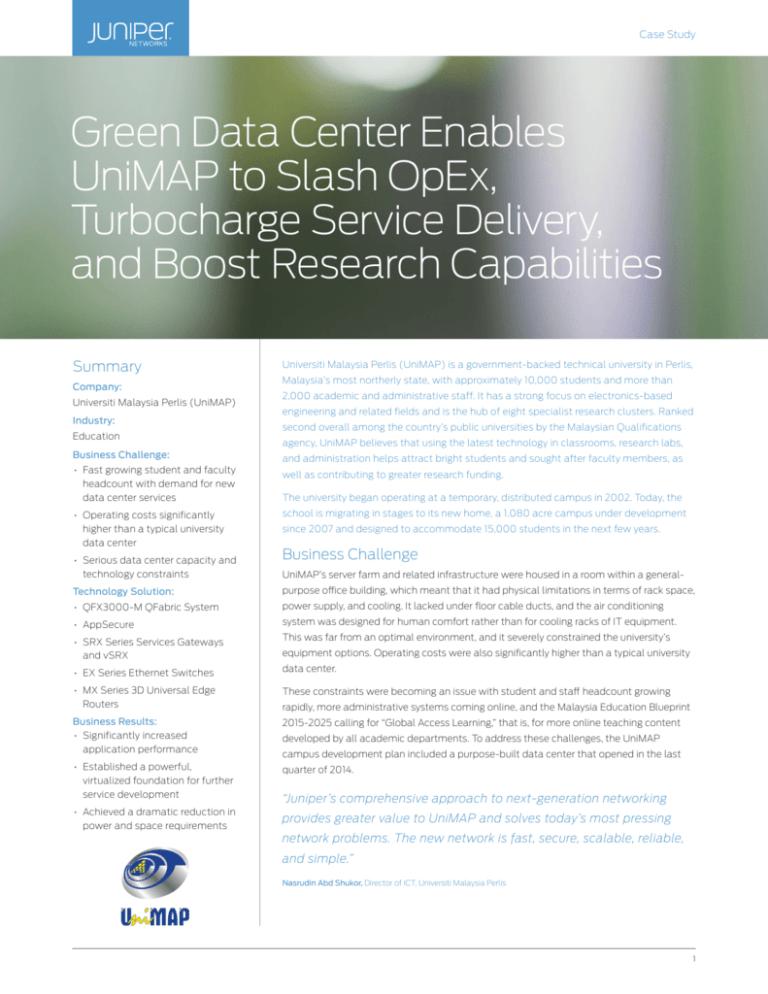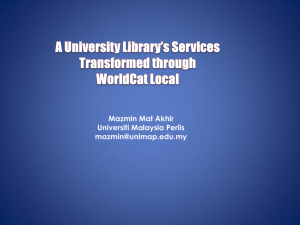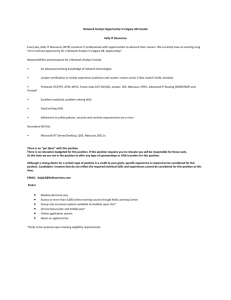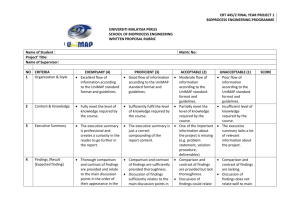
Case Study
Green Data Center Enables
UniMAP to Slash OpEx,
Turbocharge Service Delivery,
and Boost Research Capabilities
Summary
Company:
Universiti Malaysia Perlis (UniMAP)
Industry:
Education
Universiti Malaysia Perlis (UniMAP) is a government-backed technical university in Perlis,
Malaysia’s most northerly state, with approximately 10,000 students and more than
2,000 academic and administrative staff. It has a strong focus on electronics-based
engineering and related fields and is the hub of eight specialist research clusters. Ranked
second overall among the country’s public universities by the Malaysian Qualifications
agency, UniMAP believes that using the latest technology in classrooms, research labs,
Business Challenge:
and administration helps attract bright students and sought after faculty members, as
• Fast growing student and faculty
headcount with demand for new
data center services
well as contributing to greater research funding.
• Operating costs significantly
higher than a typical university
data center
school is migrating in stages to its new home, a 1,080 acre campus under development
• Serious data center capacity and
technology constraints
The university began operating at a temporary, distributed campus in 2002. Today, the
since 2007 and designed to accommodate 15,000 students in the next few years.
Business Challenge
UniMAP’s server farm and related infrastructure were housed in a room within a general-
Technology Solution:
purpose office building, which meant that it had physical limitations in terms of rack space,
• QFX3000-M QFabric System
power supply, and cooling. It lacked under floor cable ducts, and the air conditioning
•AppSecure
system was designed for human comfort rather than for cooling racks of IT equipment.
• SRX Series Services Gateways
and vSRX
This was far from an optimal environment, and it severely constrained the university’s
• EX Series Ethernet Switches
data center.
• MX Series 3D Universal Edge
Routers
These constraints were becoming an issue with student and staff headcount growing
Business Results:
• Significantly increased
application performance
2015-2025 calling for “Global Access Learning,” that is, for more online teaching content
• Established a powerful,
virtualized foundation for further
service development
quarter of 2014.
• Achieved a dramatic reduction in
power and space requirements
provides greater value to UniMAP and solves today’s most pressing
equipment options. Operating costs were also significantly higher than a typical university
rapidly, more administrative systems coming online, and the Malaysia Education Blueprint
developed by all academic departments. To address these challenges, the UniMAP
campus development plan included a purpose-built data center that opened in the last
“Juniper’s comprehensive approach to next-generation networking
network problems. The new network is fast, secure, scalable, reliable,
and simple.”
Nasrudin Abd Shukor, Director of ICT, Universiti Malaysia Perlis
1
Green Data Center Enables UniMAP to Slash OpEx, Turbocharge Service Delivery, and Boost Research Capabilities
Case Study
“We knew the new data center was in the pipeline, so decisions
UniMAP is the first site in Malaysia to deploy Juniper Networks®
had to be made about the upgraded compute, storage, and
QFabric® System technology in the form of the QFX3000-M
network facilities to deploy when the data center became
QFabric System. The QFX3000-M flattens the data center
available,” says Nasrudin Abd Shukor, UniMAP’s director of ICT. “We
network to a single tier where all access points are equal,
had 100 servers running in the old server room, and the data center
eliminating the effects of network locality and making it the ideal
at the new Pauh Putra campus was designed to accommodate
network foundation for virtualized data center operations. The
more than 20 standard equipment racks—enough to house 200
Juniper Networks QFX3500 switches, used as QFabric Nodes in
physical servers.
UniMAP’s QFabric System, provide a high density of 10GbE server
“From the outset, Pauh Putra was developed under a Green
Campus policy, and in the years since the architectural plans for
the data center were originally drawn up, huge progress had been
made in the field of data center virtualization,” Nasrudin says. “It
was clear that we should implement cloud computing within the
new data center.”
The challenge for Nasrudin and his team was how to source
and deploy the right server, storage, and network systems to
realize this vision, with the understanding that an advanced
network infrastructure was critical to enabling data center-wide
virtualization. A solution also had to be found for delivering data
center service to students and faculty still working in temporary
facilities nearly 15 kilometers away from the new campus.
Technology Solution
Given the fixed timetable for data center construction, the
UniMAP ICT team was able to spend two years studying the
options and assembling a technical specification, which was
approved by Malaysia’s Ministry of Education before a tender
was issued to all qualified vendors registered with the Ministry of
Finance.
“The new network had to maximize the potential of ICT services
while meeting our infrastructure needs for the next decade,”
Nasrudin says. “We understood traditional multitier switching
architectures couldn’t provide applications and users with
predictable latency and uniform bandwidth. Also, in a cloud
computing environment, performance is sensitive to how virtual
machine host systems are distributed and connected because
there’s a lot of server-to-server traffic. The conclusion was
that we needed to exploit leading-edge technology to build
a smarter network that could optimize performance, simplify
implementation, and reduce costs.”
Since UniMAP’s new data center would focus on highperformance computing capability as well as improving the
university’s business continuity, the key selection criteria were
low-latency performance, scalability, and operational simplicity.
According to Nasrudin, UniMAP ultimately chose the Juniper
Networks solution because it answered the university’s need to
deliver a better user experience and operational economics.
“Juniper’s comprehensive approach to next-generation
networking provides greater value to UniMAP and solves today’s
access ports and 40GbE links to other Nodes. The QFX3500
switches also act as Fibre Channel over Ethernet (FCoE)
transit switches and support FCoE-to-Fibre Channel gateway
functionality, enabling UniMAP to easily transition its SAN-based
storage environment into the new data center.
Virtual network security, another key element of the total
solution, is delivered by Juniper Networks vSRX virtual security
solution that provides stateful firewalling as well as intrusion
detection and antivirus protection. Outside the virtual
environment, Juniper Networks AppSecure, a next-generation
application security suite running on a cluster of Juniper Networks
SRX3400 Services Gateways, was also deployed to protect
UniMAP’s web-based services. AppSecure delivers application
visibility and control to defend against a broad spectrum of
threats. With granular user- and application-level control,
AppSecure provides advanced capabilities to detect and block
at Layer 7, including the ability to track network traffic and
understand user behavior, prioritize/rate-limit applications via
quality of service (QoS), and deliver full support for SSL traffic
inspection.
Other elements of the solution include the Juniper Networks
EX4550 Ethernet Switch to provide DMZ connectivity, and Juniper
Networks MX80 3D Universal Edge Router to provide connectivity
to remote campus locations. All Juniper Networks switching,
routing, and security devices deployed at UniMAP run the Juniper
Networks Junos® operating system, a high-performance network
OS that streamlines the orchestration of operations across the
network. The entire data center network is managed with Juniper
Networks Junos Space Network Director, giving UniMAP’s ICT
Center staff the ability to visualize, analyze, and control the entire
physical and virtual network through a single pane of glass.
The total solution also included network design consulting by
Juniper Networks Professional Services and an implementation
team made up of engineers from Malaysian IT solution provider,
Celestra Network Communications, and JMA Information
Technology, a U.S.-based Juniper Networks partner with expertise
in QFabric System deployments.
“While it is good to know we’ve increased the
performance and efficiency of our existing systems,
at the end of the day deployment of the Juniper
most pressing network problems,” he says. “The new network is
Networks data center solution is all about what it
fast, secure, scalable, reliable, and simple.”
enables us to do in the future.”
Nasrudin Abd Shukor, Director of ICT, Universiti Malaysia Perlis
2
Green Data Center Enables UniMAP to Slash OpEx, Turbocharge Service Delivery, and Boost Research Capabilities
Case Study
Business Results
Next Steps
UniMAP’s new data center was fully online in February 2015
As a result of establishing a virtualized infrastructure, UniMAP
following a smooth deployment of the new network, together
has a lot more space to spare within the new data center than
with compute and storage resources and the migration of all
was envisioned when it was originally planned. The QFX3000-M
applications and services from the old server farm. Instead
QFabric System also has tremendous scalability potential, as it
of using 100 physical servers to run about 50 management
can be expanded up to 768 wire-speed ports while delivering a
information systems, these now reside on virtual machines
uniform average latency of just three microseconds.
running on a pair of high-capacity blade servers, which occupy
less than a single rack.
“As well as providing plenty of headroom to scale our data center
operations, this is also an opportunity to create a new revenue
In line with UniMAP’s Green Campus policy, there’s been a
stream for UniMAP,” Nasrudin says. “In collaboration with the
dramatic reduction in the energy needed to deliver data center
university’s business arm, we are planning to enter the cloud data
services. Thanks to its energy-efficient design and the fact that
center business, hosting services and acting as a disaster recovery
there are fewer devices than a conventional three-tier switching
site for local government departments in the state of Perlis.”
architecture, the QFabric System requires up to 89% less power,
while the server virtualization and consolidation enabled by
For More Information
the QFabric System technology yields another big cut in power
To find out more about Juniper Networks products and solutions,
consumption. An efficient hot air containment system also
please visit www.juniper.net.
minimizes cooling demands while the modular UPS is matched
About Juniper Networks
to the power required by operational devices, eliminating
underutilization that would entail extra power.
Juniper Networks is in the business of network innovation. From
devices to data centers, from consumers to cloud providers,
“The planned total input power to the new data center is about
Juniper Networks delivers the software, silicon and systems that
140 Kw, while the total ICT power is about 81 Kw, so that gives
transform the experience and economics of networking. The
us a power usage effectiveness ratio of 1.7, where a score of one
company serves customers and partners worldwide. Additional
is the goal,” Nasrudin says. “As a benchmark, Google is said to
information can be found at www.juniper.net.
have a ratio of 1.21 across all its data centers, which obviously
enjoy greater economies of scale than we do, so I think this is an
excellent result.”
He says that while the ICT center only tends to hear from
UniMAP’s end users when there are service outages, there has,
in fact, been a significant improvement in application response
times thanks to the uniform low latency between QFabric System
ports. This makes a perceivable difference according to a group
of ICT staff that tested every operational application system and
observed the response times.
“This is as you would expect. While it is good to know we’ve
increased the performance and efficiency of our existing system,
at the end of the day, the deployment of the Juniper Networks
data center solution is all about what it enables us to do in the
future,” Nasrudin says.
Corporate and Sales Headquarters
APAC and EMEA Headquarters
Juniper Networks, Inc.
Juniper Networks International B.V.
1133 Innovation Way
Boeing Avenue 240
Sunnyvale, CA 94089 USA
1119 PZ Schiphol-Rijk
Phone: 888.JUNIPER (888.586.4737)
Amsterdam, The Netherlands
or +1.408.745.2000
Phone: +31.0.207.125.700
Fax: +1.408.745.2100
Fax: +31.0.207.125.701
www.juniper.net
Copyright 2015 Juniper Networks, Inc. All rights reserved. Juniper Networks, the Juniper Networks logo, Junos
and QFabric are registered trademarks of Juniper Networks, Inc. in the United States and other countries.
All other trademarks, service marks, registered marks, or registered service marks are the property of their
respective owners. Juniper Networks assumes no responsibility for any inaccuracies in this document. Juniper
Networks reserves the right to change, modify, transfer, or otherwise revise this publication without notice.
3520540-001-EN July 2015









